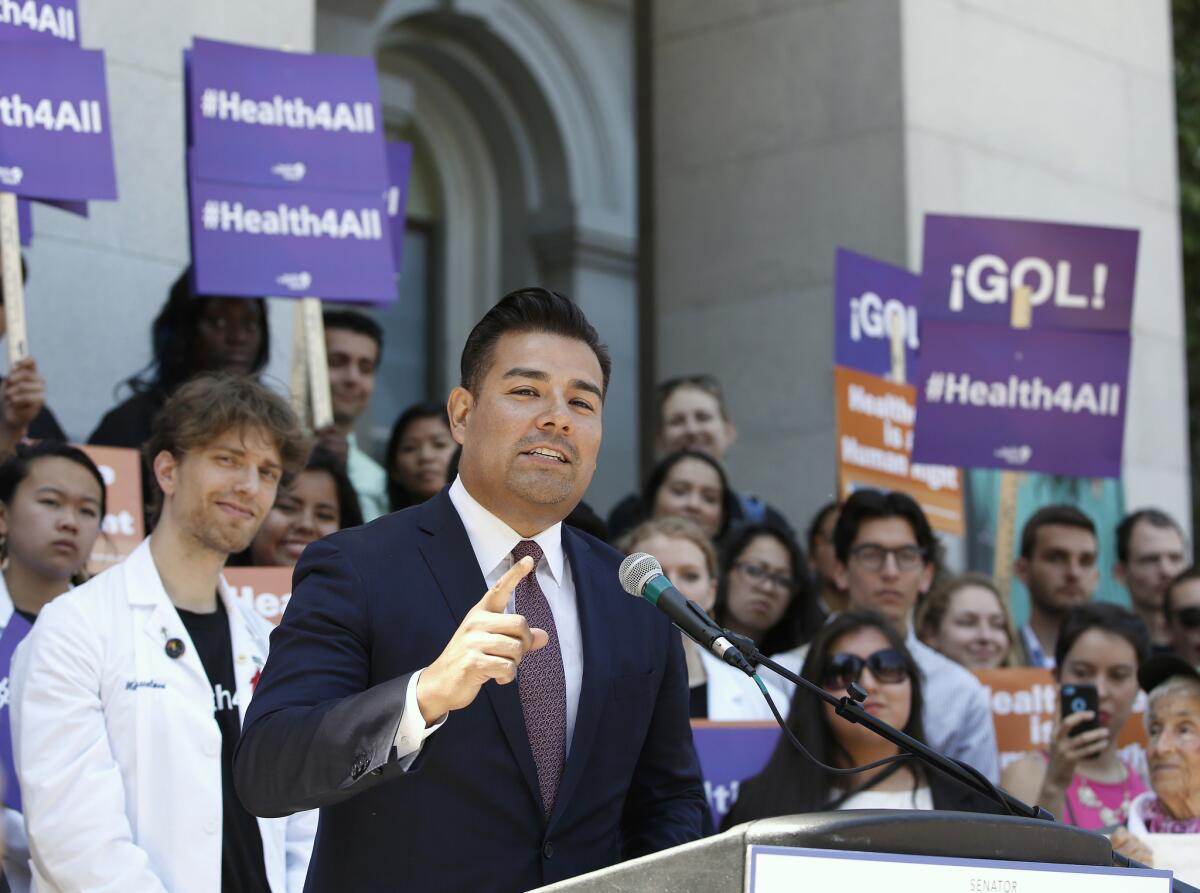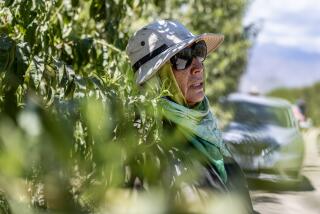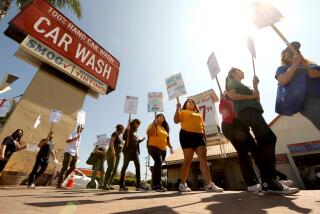Newsletter: When Robert Frank came to California
- Share via
Good morning, and welcome to the Essential California newsletter. It’s Wednesday, Sept. 11, and I’m writing from Los Angeles.
Get the Essential California newsletter »
Robert Frank — who, at 94, had arguably been the most influential living photographer in the country — died Monday.
His midcentury masterwork “The Americans” was the product of a two-year, 10,000-mile journey around the United States funded by a Guggenheim grant. Frank shot 27,000 frames on 767 rolls of film. His aim, as he wrote in his Guggenheim application, was “to portray Americans as they live at present. Their every day and their Sunday, their realism and dream. The look of their cities, towns and highways.”
Despite its now unshakable place in the pantheon, the book was largely panned when it was officially released in the U.S. in 1960. The rough-looking photos, of dim bars and drive-ins and roadside crosses, were grainy and restless. “Robert Frank,” as Jack Kerouac wrote in his introduction to the book, “Swiss, unobtrusive, nice, with that grey little camera he raises with one hand he sucked a sad poem right out of America onto film, taking rank among the tragic poets of the world.” That tragic poetry was, for many at the time, considered to be a direct affront to the prevailing, golden-hued image of 1950s America. And the fact that the photos were taken by a Leica-toting European émigré Jew probably didn’t help matters.
Frank crisscrossed the country for the project but spent longer in California than anywhere else on his travels. He was on the West Coast with his family for months, first in Los Angeles and then Orinda, pausing for a time to reflect and develop film even as he continued to shoot.
He had already been on the road for several months when his wife, Mary, and their two small children joined him in Houston in November 1955. They got to L.A. on or just before Christmas Day 1955 and spent two months in a rented house in the Hollywood Hills, near where Mulholland Drive meets the Cahuenga Pass.
Here in L.A., Frank tried and mostly failed at securing commercial assignments to supplement the family’s income, according to a chronology of his trip from the National Gallery of Art.
He developed film in a friend’s darkroom, editing the negatives with scissors as he went, and took pictures at movie premieres, auto shows and elsewhere.
One particularly well-known photo, of a diner waitress staring unguardedly ahead, was shot at the Hollywood Ranch Market on Vine. The long-since-gone Ranch Market “was one of the few places [in L.A.] where a person could cash a check in the middle of night. It had metal turnstiles, pinball machines, but no doors,” according to historian Alison Martino of Vintage Los Angeles.
“While he explored, Mary and the kids remained in the apartment. He admitted to his parents that Mary had it rough because she couldn’t drive and they couldn’t afford a babysitter — to be carless and stranded in L.A. is a cruel isolation,” RJ Smith wrote in “American Witness,“ his biography of Frank. Mary was only 23 at the time, and both children were under 5.
Meanwhile, Frank continued his meanderings in the most American of automobiles — a used Ford. Another L.A. photo, “St. Francis, Gas Station and City Hall, Los Angeles,” taken on the fringes of downtown, was erroneously titled. The statue in the foreground is actually of Junipero Serra, the founder of California’s missions.
“To live for two months in L.A. is like being hospitalized in a Paris hospital,” Frank wrote in a letter to Walker Evans in February 1956, according to Smith’s book. “If you have to stay longer one gets worse quickly.”
The Frank family stayed in Los Angeles for three months before heading up to Orinda.
And now, here’s what’s happening across California:
TOP STORIES
With a deadline nearing, California state senators advanced sweeping legislation Tuesday night to limit the number of Californians classified as independent contractors. (Also known as Assembly Bill 5, or the gig-worker bill, or the thing that Uber and Lyft have been bitterly fighting.) And after an intense lobbying campaign, lawmakers also made a last-minute deal that would ease the measure’s effects on the newspaper industry. Senators approved AB 5 after two hours of debate, which included GOP senators offering a dozen failed amendments that would have exempted some truck drivers, physical therapists and other workers. The measure still requires passage in the state Assembly before the end of the week when the Legislature adjourns for the year. Gov. Gavin Newsom has endorsed the bill. Los Angeles Times
Fuel breaks won’t stop the worst wildfires. So why is California spending millions on them? (Fuel breaks generally consist of strips of wild land where vegetation has been completely or partly removed. They are not designed to stop wildfires on their own, but to give firefighters a place to establish control lines and set backfires.) Los Angeles Times
L.A. STORIES
Trump officials visited L.A. to assess the homelessness crisis. The officials spent Monday and Tuesday meeting with officials from Mayor Eric Garcetti’s office, at Jordan Downs in Watts and touring the long-entrenched epicenter of the crisis, skid row. Los Angeles Times
In 2018, there was a lot of uncertainty about the future of Amtrak’s L.A.-to-Chicago line. We sent a travel writer on the trip to see what’s changed. Los Angeles Times
Want to experience Larry David’s Los Angeles? There’s a tour for that. Los Angeles Times
Shaquille O’Neal is opening a fast casual chicken restaurant across the street from the Americana at Brand in Glendale. Eater LA
Finally, an answer to the question that has dogged Hollywood cocktail party chatter for decades: What movie was the biggest bomb of all time? The Hollywood Reporter
Your support helps us deliver the news that matters most. Subscribe to the Los Angeles Times.
POLITICS AND GOVERNMENT
California schools will no longer be able to suspend students in elementary and middle school for disrupting school activities or “willfully defying” the authority of teachers or administrators, ending a practice that many say is counterproductive and unfairly applied to black students. Newsom signed the legislation late on Monday. Los Angeles Times
The Ricardo Lara saga continues: California’s insurance chief vowed not to take industry money. Records show he did, and knew it. Also: “Social media posts shared with The Bee show Lara also counts insurance lobbyists among his friends. The former state lawmaker partied with a Farmers Insurance lobbyist in London on New Year’s Eve just a week before his inauguration.” Sacramento Bee

The director of the state Department of Health Care Services resigned after criticizing anti-vaccine activists on Facebook. The top healthcare official had referred to vaccine bill protesters as “flat-earthers.” Los Angeles Times
Two homeless encampments are being cleared in Oakland and Berkeley over advocates’ objections. San Francisco Chronicle
CRIME AND COURTS
The NRA is suing San Francisco after San Francisco supervisors labeled it a “domestic terrorist organization.” San Francisco Chronicle
Forty-eight states are probing Google on antitrust grounds. Why isn’t California? Los Angeles Times
Battle in the college admissions scandal: As a judge in Boston prepares to sentence parents in the college admissions cheating scandal, an important question has emerged. Should parents who paid the biggest bribes get the biggest punishment? Los Angeles Times
HEALTH AND THE ENVIRONMENT
These are the big fires burning in California now. Although this fire season appears to be off to a comparatively slow start, officials have warned that historically, September and October are the worst months for wildfires in the state. Los Angeles Times
California hospitals and nursing homes are bracing for wildfire blackouts. The potential for multiple prolonged shutoffs has prompted new disaster preparations by hospitals, nursing homes and home care providers charged with protecting the health of medically fragile patients. California Healthline
CALIFORNIA CULTURE
Today is the 18th anniversary of the Sept. 11 attacks. Here are some ways around Northern California to commemorate those tragic events. Mercury News
And some 9/11 memorial events in and around Los Angeles. Daily News
Apple ups the stakes in streaming wars with a lower-than-expected $4.99-a-month price for its much-anticipated streaming service. Apple TV+ would launch Nov. 1. Los Angeles Times
After a two-year rebranding process, Kern County and Bakersfield have new logos and taglines. (Bakersfield’s new tagline will be “The Sound of Something Better.”) Bakersfield Now
CALIFORNIA ALMANAC
Los Angeles: sunny, 81. San Diego: partly sunny, 75. San Francisco: sunny, 74. San Jose: sunny, 84. Sacramento: sunny, 89. More weather is here.
AND FINALLY
“So few human contacts in Los Angeles go unmediated by glass (either a TV screen or an automobile windshield) that the direct confrontation renders the participants docile, stunned, sweet.”
— — Edmund White
If you have a memory or story about the Golden State, share it with us. (Please keep your story to 100 words.)
Please let us know what we can do to make this newsletter more useful to you. Send comments, complaints, ideas and unrelated book recommendations to Julia Wick. Follow her on Twitter @Sherlyholmes.
Note: Yesterday’s newsletter erroneously cited The Times as the source of a KCRW story on the only black-owned bank in the western U.S.
More to Read
Sign up for Essential California
The most important California stories and recommendations in your inbox every morning.
You may occasionally receive promotional content from the Los Angeles Times.











